Graeme Davis and Gene Tunny1
It is often argued that Australia’s research and development (R&D) effort is low when compared with other OECD countries. While business expenditure on R&D in Australia appears relatively low, this is, to a significant extent, a result of Australia’s industry structure. Also, it does not appear that policy towards business R&D is the main driver of R&D intensity. Countries with policies that promote R&D are typically not high R&D-spending countries. Finally, the relationship between R&D and more direct measures of innovation does not appear to be strong or stable across countries. R&D is one input into the process of innovation — the development of new products, services and business processes — that is a key driver of economic growth. Having lower levels of R&D expenditure does not necessarily mean a country is less innovative.
Introduction
One of the often-heard arguments in Australia is that, at around 1.6percent of GDP, R&D is low when compared with other OECD countries. This line of argument observes that R&D is important for innovation and economic growth in terms of both developing and absorbing new ideas.2 There is a concern that if R&D is low then this will hold back innovation — the development of new products, services and business processes— and economic growth. Therefore, it is argued that Australia should have a higher level of R&D, with some suggestion that an appropriate target would be the OECD average of around 2.2 percent of GDP or above.3
A number of R&D spending targets have emerged in OECD countries and the European Union (EU), as illustrated in Table1.
Table 1: Examples of R&D spending targets
|
Country/region |
R&D intensity in 2002 |
R&D target |
Target date |
|
European Union |
1.85 |
3.0percent of GDP |
2010 |
|
Austria |
2.12 |
2.5percent of GDP |
2006 |
|
Canada |
1.96 |
Top 5 in OECD |
2010 |
|
Germany |
2.53 |
3.0percent of GDP |
2010 |
|
Hungary |
1.02 |
OECD average |
2006 |
|
Korea |
2.53 |
Double national investment in R&D |
2007 |
|
Norway |
1.67 |
At least OECD average |
2005 |
|
Spain |
1.03 |
1.4percent of GDP |
2007 |
Source: OECD (2004, 2005).
These targets are either expressed as a percentage of GDP in the country in question or relative to the OECD average, and are generally driven by the same logic outlined earlier — if a country does less R&D it will fall behind, and if it does more than the OECD average, it will make up ground or move ahead, in terms of economic growth. For example, the European target is focused on achieving the goal of turning the EU into ‘the most competitive knowledge-based society in the world by 2010’ (European Commission 2002). One obvious criticism of such targets is that, by definition, some countries have to be below the OECD average.
Not everyone sees this focus on R&D as appropriate, and it has been argued that it is being used, in some areas, as a substitute for real reform. For example, Martin Baily, a former chairman of President Clinton’s Council of Economic Advisers, has argued that R&D alone is not sufficient to drive innovation and economic growth, but a competitive economy is necessary as well (Baily 2001).
This paper first considers how Australia’s R&D levels compare internationally. Then the extent to which R&D expenditure as apercent of GDP may reflect a country’s particular industry structure is investigated. The paper then looks at the possible contribution of R&D policy to R&D differences across countries, followed by a brief consideration of why policy makers focus on R&D. Finally, the extent to which cross-country differences in R&D expenditures may be related to differences in levels of innovation is examined.
How do Australia’s R&D levels compare internationally?
Australian R&D expenditure as a percent of GDP (R&D intensity) is relatively low when compared with the OECD average.4 This is true, whether looking at total R&D spending — Gross Expenditure on R&D (GERD) — or Business Expenditure on R&D (BERD) (Chart 1).
Chart 1: R&D intensities across the OECD, 2002
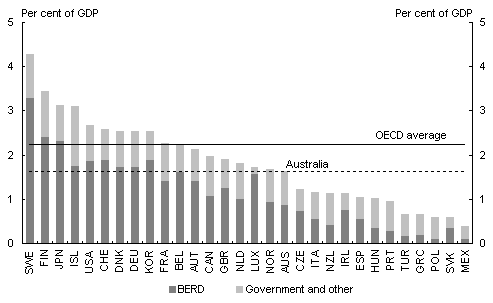
Source: OECD (2005) and ABS cat. no. 8104.0. Data are for 2002 or nearest available year.
Note: This chart uses updated BERD data for Australia for 2002-03 from ABS cat. no. 8104.0.
GERD is defined as total expenditure by all sectors — business enterprise, government, private non-profit, higher education — on R&D that is performed within the boundaries of the country. That is, overseas-funded R&D that is performed locally is included, but locally-funded R&D that is performed overseas is excluded (OECD2002). BERD is that part of GERD where the expenditure on R&D is made, although not necessarily funded, by the business enterprise sector.
In 2002, Australia’s GERD intensity was 1.6percent of GDP compared with an OECD-average GERD intensity of 2.2 to 2.3 percent of GDP. Australia’s BERD intensity in 2002 was 0.9percent of GDP compared with an OECD-average BERD intensity of around 1.5percent of GDP. In understanding the factors underlying these differences it is useful to consider R&D expenditures by activity type.
R&D expenditures by activity type
The OECD (1993) categorises R&D expenditures into three activity types: basic research; applied research; and experimental development (see Appendix 1 for definitions). Chart 2 shows GERD as a percentage of GDP broken
down into these three components for Australia and three countries with higher R&D spending. As noted above, international comparisons should be interpreted cautiously, and even more so the further the data are broken down into smaller components.
Chart 2: R&D spending as a per cent of GDP, by group, 2000
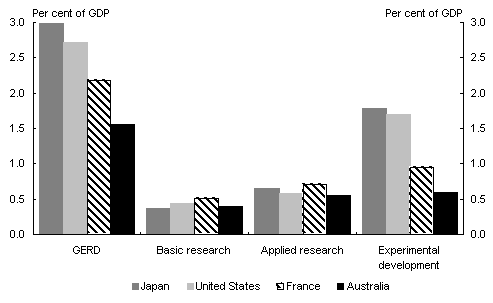
Source: OECD Research and Development Statistics database.
As Chart 2 shows, there is relatively little gap between Australia and the three higher spending countries in terms of basic and applied research, which together make up the ‘R’ of R&D. In 2000, Australia spent 0.95percent of GDP on basic and applied research, compared with 1.02percent in Japan and the United States, and 1.23percent of GDP in France.
However, the difference in expenditure on experimental development — the ‘D’ of R&D — is substantial, with Australia’s expenditure being over 1percentage point less than Japan or the United States. That is, Australia’s R&D gap versus the UnitedStates is almost solely determined by expenditure on experimental development. This picture is confirmed when the R&D expenditure of business is considered (Chart 3).
Chart 3: Business R&D spending as a per cent of GDP, by group, 2000
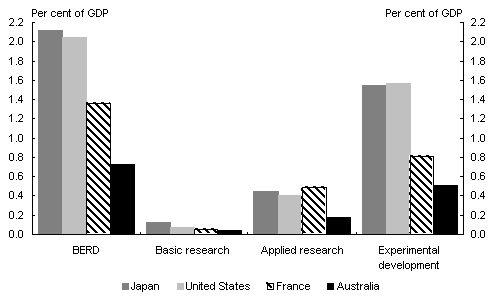
Source: OECD Research and Development Statistics database.
Business expenditure on R&D in Australia is low in all of the categories, but the absolute gap is smaller for the two research categories. Businesses in Australia spend around 0.2percent of GDP on basic and applied research by business, compared with 0.5 to 0.6percent spent by businesses in Japan, the United States and France. Also, business expenditure on experimental development is very low in Australia — less than a third of what the United States or Japan spends. It is clear that this accounts for the vast bulk of Australia’s below-average R&D spending.
Australia’s comparatively high non-business R&D spending on applied research (Chart 4), by government, non-profit, and higher education sectors, brings total applied research in Australia up to levels comparable with the other countries.
Chart 4: Non-business R&D spending as a per cent of GDP,
by group, 2000
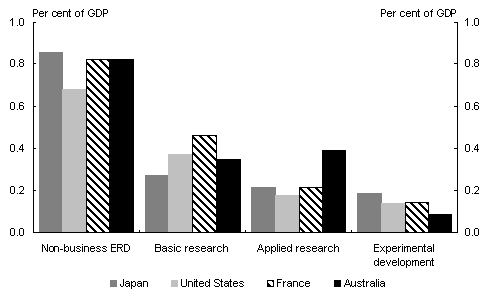
Source: OECD Research and Development Statistics database.
Note that total non-business R&D for Japan includes 0.2percentage points of R&D not allocated into the three disaggregated types.
In summary, Australia’s lower R&D intensity is principally explained by lower applied research and experimental development by the business sector. This may be related to the nature of Australia’s industry structure. For example, experimental development might be higher in Japan and the US due, in part, to the larger relative size of industry sectors that undertake experimental development, such as vehicle manufacturing and electronics.
Does industry structure matter?
It has been recognised for many years that industry structure explains a lot of the difference in R&D intensities — both BERD and GERD — between countries. Different industries use R&D inputs more or less intensively. This variation occurs for a range of reasons, only some of which may be policy-related. For example, Sheehan and Wyckoff(2003) argue:
A country’s R&D intensity is largely a reflection of its industrial structure. Countries with high R&D intensities have a high share of their business R&D and a significant part of their economic output in high-technology sectors.5 In Finland, Germany, Japan, Switzerland and the United States, these industries account for three-quarters or more of business-performed R&D. In low R&D-intensity countries, such as Norway and Australia, high-technology industries (and medium-high technology industries) account for less than 40percent — a fact that can be attributed to the natural resource endowments that these countries enjoy that affects their industrial structure. (Sheehan and Wyckoff 2003, page 20).
Sheehan and Wyckoff (2003) found that, for EU countries, meeting the EU targets for R&D would be unlikely to be achieved by increasing business R&D intensities within the existing industry structure. They argued it would require a significant change in industry structure. It is unclear what would drive such a change in industry structure, or why such a change would be considered desirable in a broader sense.
What about Australia? Hypothetically, if it was considered desirable for Australia to be at or above the OECD average, would it require either higher business R&D intensities within the existing industry structure, or a change in the industry structure, or both? The following analysis suggests that a change in industry structure would be required.
One way to consider the relationship between industry structure and business R&D intensity is to ask the following questions:
- If Australia operated in each industry sector at the business R&D intensities of large high-intensity countries, such as Japan or the United States, what would be the overall BERD intensity?
- If Australia operated at the highest business R&D intensities found in each industry sector across a range of countries what would be the overall BERD intensity?
In exploring these questions, the proportions of GDP spent on R&D in manufacturing, electricity, gas and water, and construction were looked at. Note that some industries with significant R&D — mining, for example — are not covered by the OECD ANBERD database.6 However, the industries for which comparative data are available cover the majority of BERD across the countries considered. In 1999 in the US, R&D in these sectors represented around 1.2percent of GDP (compared with BERD of around 2percent of GDP), while for Australia this was 0.33percent of GDP (compared with BERD of 0.66percent of GDP in 1999).7
This exercise makes use of sub-industry data, with manufacturing sub-industries such as chemical and chemical products identified (see Appendix 2). This is important from an analytical perspective because the variation in industry structures is likely to be greater across countries when sub-industries are considered. For example, the sub-industry data may show that a country does not have high-technology manufacturing industries that undertake large amounts of R&D, even though industry-level data may show that the country has a significant manufacturing sector.
Business R&D intensities in 15 sub-industries were calculated for the United States, Japan, France, Germany, Italy and Canada. These intensities were then applied to Australia’s industry structure to see what difference they would make (Chart 5). That is, Australia’s industry structure was held constant, while the BERD intensities in sub-industries were adjusted to the levels seen in other countries.
Chart 5: R&D in manufacturing, electricity, gas and water, and construction as a per cent of GDP, 1999
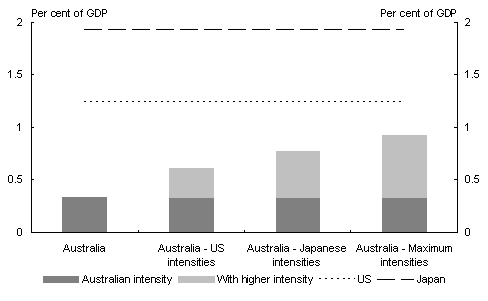
Source: Australian Government Treasury calculations based on OECD ANBERD and STAN databases.
If Australia were hypothetically to achieve US business R&D intensities in these sectors it would only imply an increase in business R&D spending in Australia from 0.33 to 0.61percent of GDP — still less than half the US intensity. If Australia adopted Japanese intensities, spending would move up to 0.77percent of GDP — again less than half of the Japanese intensity of around 2percent of GDP. If Australia adopted the highest intensities found in the sample in each industry for any country, spending would move up to around 0.9percent of GDP, moving Australia above Canada (0.7percent) but remaining below France and the United States (both at around 1.2percent).
It is likely that the broad conclusions of this analysis would remain unchanged if there were BERD data available for all sub-industries, and not just those in manufacturing, construction, and electricity, gas and water. In part, the importance of these exclusions can be tested by looking at only that proportion of GDP covered by these sectors.8
When the R&D numbers are run against GDP generated in manufacturing, electricity, gas and water, and construction, the story remains similar. The adoption of either US or Japanese intensities would still leave a significant gap in aggregate business R&D intensities between Australia and other countries. Similarly, when the highest intensities across the sample of countries in each sub-sector are applied to Australia’s industry structure, the aggregate business R&D intensity in Australia still remains below those of France, Japan and the US.
Industry structure, policy and R&D
Clearly, a major factor behind observed outcomes for R&D expenditures as a share of GDP is industry structure. Industry structures reflect a complex set of factors including geographic location, natural endowments, history and economic policy. Historically, government purchasing decisions have also influenced industry structures — the development of aviation and computer software industries in the US being examples (Lipsey and Carlaw 2002). Nonetheless, the influence of contextual factors means that industry structures are likely to change only gradually over time.
Australia is one of the most remote developed economies in the world, with a small population and a vast internal geography. In addition, Australia has many natural endowments — resource deposits and climatic conditions, for example — and historical linkages that will, to some extent, shape the industry structure. These factors are not static — they change over time in both an absolute and relative sense, although such changes are likely to be very gradual.
Thus policy can influence R&D in two ways. Through creating a policy environment in which firms have incentives to innovate, policy may increase the returns to R&D and the amount of R&D undertaken. There is significant evidence that competition is strongly related to innovation and productivity growth (Baily 2001; Baily and Gersbach 1995). Alternatively, policy can directly influence R&D through direct funding of R&D or through tax concessions that favour R&D expenditures.
The role that policy plays in directly influencing R&D expenditure might be secondary to the roles that context and industry structure play. There are some OECD data available that allow a preliminary investigation of the direct role of policy in influencing R&D.
Chart 6 presents a plot of BERD intensity and government direct support for BERD as apercent of GDP. Government direct support comprises a mixture of grants and contracts with the private sector for activities with an R&D component. Australia provides relatively little direct support for BERD as a percentage of GDP compared with other OECD countries. In part, this reflects policy choices made by governments and, in part, might reflect the existing mix of firms in the economy. It is evident from Chart 6 that there is at most only a very loose correlation between the level of direct government support for BERD and the level of BERD as a share of GDP.
Chart 6: BERD as a per cent of GDP and government direct
support for R&D, 2002
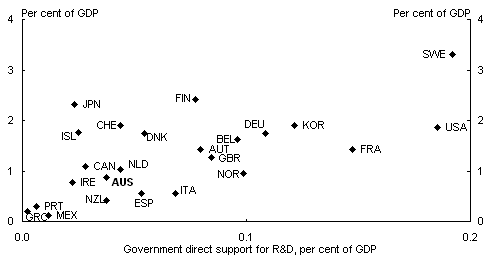
Source: OECD (2005).
In contrast to direct support, Australia has relatively generous tax concessions supporting BERD when compared with other OECD countries.9 It is also worth noting that some of the countries traditionally used as examples of high R&D-spending countries, particularly Japan, have tax systems that provide little if any support for R&D, and certainly less than Australia. Chart 7 plots BERD intensity against the generosity of the tax system to R&D expenditures.10
Chart 7: BERD as a percent of GDP and generosity of
tax subsidies, 2002
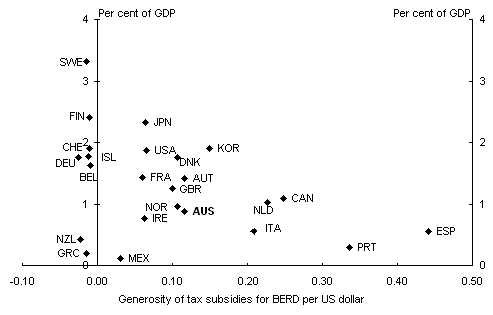
Source: OECD (2004, 2005) and ABS cat. no. 8104.0.
Notes: Government support for R&D is calculated as 1 minus the B-index for 2001. Further information can be found in Warda (2001). Note that the 2004 generosity figure for Australia is used due to the 2001 figure being over-estimated, as discussed in OECD (2005, p. 214, fn. 2). Generosity of tax subsidies for Canada, Italy, Japan, Netherlands, Norway and the UK was calculated as the average of the generosity of tax subsidies for small to medium enterprises and large enterprises.
The lack of any distinct correlation between the indicators in Charts 6 and 7 and the BERD intensities of these countries is consistent with the discussion above that there are other major forces at work that determine industry structures and consequent spending on R&D.
Strikingly, the relationship between the generosity of the tax system and BERD illustrated in Chart 7 seems, if anything, to be negative across countries. This may suggest reverse causality. That is, countries with relatively low BERD are inclined to offer more generous tax concessions.
Broadly speaking, the effectiveness of direct support and tax concessions in influencing R&D is unclear. Chart 8 shows trends in GERD as a percent of GDP for a number of countries. This shows that, despite significant changes in the nature and generosity of tax concessions for R&D in many countries over time, there has been very little long-run movement in R&D intensities for the world’s major economies, with the possible exception of Japan.
Chart 8: GERD as a per cent of GDP, 1981 to 2003
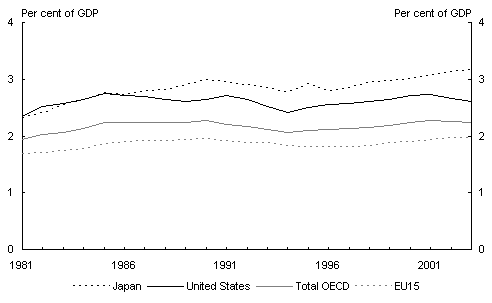
Source: OECD Main Science and Technology Indicators database, September 2005.
Even if policy were able to influence the level of R&D expenditure, R&D is only one input into the innovation process. Firms can innovate their products and business processes without necessarily spending large amounts on R&D. This raises two questions: why do policy makers focus on R&D, and what is the relationship between R&D and a broader concept of innovation?
Why do policy makers look at R&D?
The inte
rest of policy makers in R&D is heightened by the recognition that, with the projected decline in the growth of the population of traditional working age, productivity improvements are going to be essential to economic growth in future years. Clearly, innovation is an important driver of growth, as noted by the OECD (2001). However, the focus on R&D intensities might, in part, be a case of looking under the lamp post because that is where the light is. Sheehan and Wyckoff (2003) argue that:
This interest persists notwithstanding the fact that the weaknesses of this indicator are well known, most notably that it measures only one type of Science and Technology (S&T) input (R&D) and not the results or S&T outputs. A primary reason why the indicator of R&D intensity is more popular than other data such as commercial successes from innovation or fundamental breakthroughs or the diffusion and adoption of technological advances that will boost productivity is that R&D spending is a quantifiable entity that has been measured in OECD countries for some 40years. Furthermore, numerous econometric studies have demonstrated a quantifiable relation to economic growth that has been growing over time, providing further justification for efforts to improve economic performance by boosting R&D spending. (Sheehan and Wyckoff 2003, page 8).
Although R&D spending is related to economic growth, correlation does not necessarily imply causation. And it is innovation in the economy that drives productivity improvements and economic growth, to which R&D is only one input.
The link between business R&D and innovation
Innovation is a broad concept, including product innovation, plus all the process innovations firms continually employ in their workplaces to increase efficiency and productivity. It therefore encompasses a vast array of activities in the economy, including workforce skills, management, venture capital, technology uptake, work re-organisation and R&D. That is, R&D is only one of many inputs into innovation.
The OECD (2001, p. 51) has defined innovation as ‘the development, deployment and economic utilisation of new products, processes and services.’ In the services sector, innovation depends less on formal R&D than in the manufacturing sector. This informal R&D may include ‘learning by doing’, which is not counted in BERD or GERD.
Individuals and businesses within a particular country do not necessarily have to undertake R&D expenditures to innovate, but can for example take advantage of the technology embodied in newly imported goods and services, especially of the information and communications technology (ICT) type. That is, there are significant international spillovers in R&D (Coe and Helpman 1995). The significance of international spillovers in Australia’s ‘productivity revival’ is discussed in Parham(2004).
Although innovation is a broad concept that is difficult to define and measure, there are some survey data available on innovation by businesses. Consider the correlation between BERD intensity and the percentage of businesses engaged in innovation as an example (Chart 9).11 For selected European Union countries, Australia and New Zealand, the correlation is positive but relatively low. Indeed, while Finland and Sweden have much higher BERD intensities, proportionately more businesses innovate in Australia than in Finland and Sweden. The same picture can be seen when comparing the percentage of businesses engaged in innovation with GERD (Chart 10).
Chart 9: Per cent of businesses engaged in innovation and BERD as a per cent of GDP, 2001
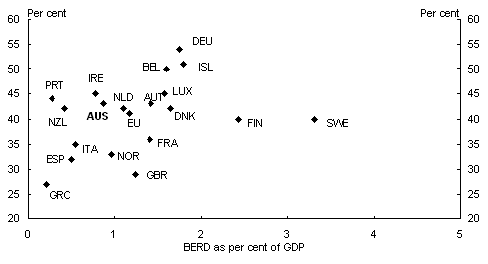
Source: BERD for 2001 is from OECD (2005) and ABS cat. no. 8104.0 for Australia; 2000 data used for Luxembourg and 2002 data used for Austria; Innovation data from ABS cat. no. 8158.0; figures are for 1998 to 2001 for European countries, and 2001 to 2003 for Australia and 2003 for New Zealand.
Chart 10: Per cent of businesses engaged in innovation and GERD as a per cent of GDP, 2001
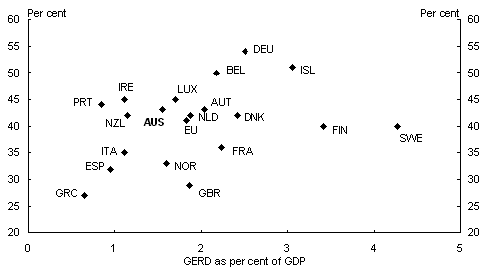
Source: GERD for 2001 is from OECD (2005); 2000 GERD data used for Australia and Luxembourg; Innovation data from ABS cat. no. 8158.0; figures are for 1998 to 2001 for European countries, and 2001 to 2003 for Australia and 2003 for New Zealand.
The point here is not that Australia does more innovation than Sweden. Rather, the point is that measures of R&D and innovation are not strongly correlated. Nor is it clear that there is a linear relationship between the input, R&D, and the output, innovation. What is clear is that our understanding of the link between R&D and innovation is at an early stage.
Looking at how Australia compares with the OECD average across a range of indicators of innovation — inputs, outputs and behaviours — the picture is mixed (Chart11). All this suggests that the relationship between innovation and any one of the indicator variables is neither simple nor stable between countries.
In summary, while Australia’s R&D intensity is below the OECD average, the implications for innovation are unclear. For example, even with below-average R&D, Australia exceeded OECD-average multi-factor productivity growth over the late1990s.
Chart 11: Australia’s innovation performance compared with the OECD average (percentage difference)
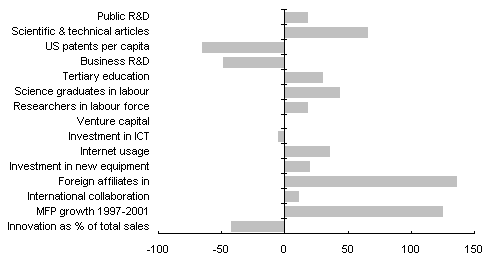
Source: Department of Education, Science and Training (2005).
Conclusion
Drawing strong policy conclusions from cross-country comparisons is always difficult. The data here are subject to considerable uncertainty. However, it would seem that, while business expenditure on R&D in Australia is relatively low by international standards, this is, to a significant extent, a result of Australia’s industry structure. Industry structures, in turn, are determined by a wide range of factors and are likely to change only gradually over time.
Further, it does not appear that the level of direct support or the generosity of tax concessions towards business R&D is the main driver of R&D intensity. Countries with policies that promote R&D directly are typically not high R&D-spending countries.
Finally, the relationship between R&D, as an indicator of innovation, and more direct measures of innovation does not appear to be strong or stable across countries. Having lower levels of business expenditure on R&D does not necessarily mean a country is less innovative. Rather it is contextual factors and the level of competition that determine innovation in a country. Operating in one of the world’s most remote economies and in a dynamic domestic market, Australian firms have incentives to innovate, but not necessarily in the same ways as firms in other countries.
References
ABS 2005, Innovation in Australian Business, cat. no. 8158.0.
Baily, M 2001, U.S. Economic Performance and the Challenge for Europe, Keynote address to the Brussels Economic Forum, European Commission, 3 May.
Baily, M and Gersbach, H 1995, ‘Efficiency in manufacturing and the need for global competition’, Brookings Papers on Economic Activity
: Microeconomics.
Coe, D and Helpman, E 1995, ‘International R&D spillovers’, European Economic Review, vol 39, pp. 859-877.
Department of Education, Science and Training 2005, Innovation Report 2004-05: Backing Australia's Ability — Real Results Real Jobs.
Dowrick, S 2003, A Review of the Evidence on Science, R&D and Productivity, Department of Education, Science and Training, Commonwealth of Australia.
European Commission 2002, Towards a Knowledge-based Europe: The European Union and the Information Society, Brussels.
Jones, C 1995, ‘R&D-Based models of economic growth’, Journal of Political Economy, vol 103, no. 4, pp. 759-84.
Lipsey, R and Carlaw, K 2002, ‘The conceptual basis of technology policy’, SimonFraser University Department of Economics Discussion Paper, no. 02-6.
OECD 1993, The Proposed Standard Practice for Surveys of Research and Experimental Development, Frascati Manual 1993, Paris.
OECD 2001, Science, Technology and Industry Outlook: Drivers of Growth: Information Technology, Innovation and Entrepreneurship, Paris.
OECD 2002, Frascati Manual: Proposed Standard Practice for Surveys on Research and Experimental Development, Paris.
OECD 2004, OECD Science, Technology and Industry Outlook, Paris.
OECD 2005, Main Science and Technology Indicators, vol. 2005/1, Paris.
Parham, D 2004, ‘Sources of Australia’s productivity revival’, Economic Record, vol 80, no. 249, pp. 239-57.
Sheehan, J and Wyckoff, A 2003 ‘Targeting R&D: economic policy implications of increasing R&D spending’, STI Working Paper 2003/8, OECD: Paris.
Warda, J 2001, ‘Measuring the value of R&D tax treatment in OECD countries’, OECD STI Review, no. 27, pp. 185-211.
Appendix 1
The OECD Frascati Manual (OECD, 1993) on R&D statistics breaks R&D expenditures down into three activity types:
- Basic Research, ‘experimental or theoretical work undertaken primarily to acquire new knowledge of the underlying foundations of phenomena and observable facts, without any particular application or use in view.’;
- Applied Research, ‘original investigation undertaken in order to acquire new knowledge … directed primarily towards a specific practical aim or objective.’; and
- Experimental Development, ‘Experimental development is systematic work, drawing on existing knowledge gained from research and practical experience, that is directed to producing new materials, products and devices; to installing new processes, systems and services; or to improving substantially those already produced or installed.’
Appendix 2
The GERD and BERD data are sourced from the OECD’s ANBERD and STAN ISIC revision 3 database.
Calculation of industry R&D intensities
The data used in the industry-based intensity calculations are sourced from the OECD’s ANBERD and STAN databases (both databases are ISIC revision 3). Data availability limited the work that could be done. Sufficient data were available for all countries at the following classification levels:
- food products, beverages and tobacco (ISIC: 15+16);
- textiles, textile products, leather and footwear (ISIC: 17+18+19);
- wood, paper, printing, publishing (ISIC: 20+21+22);
- coke, refined petroleum products and nuclear fuel (ISIC: 23);
- chemicals and chemical products (ISIC: 24);
- rubber and plastics products (ISIC: 25);
- other non-metallic mineral products (ISIC: 26);
- basic metals and fabricated metal products, except machinery and equipment (ISIC:7+28);
- machinery and equipment n.e.c. (ISIC: 29);
- electrical and optical (ISIC: 30+31+32+33);
- motor vehicles, trailers and semi-trailers (ISIC: 34);
- other transport equipment (ISIC: 35);
- furniture; manufacturing n.e.c. and recycling (ISIC: 36+37);
- EGW (Electricity, gas and water supply, ISIC: 40+41);
- construction (ISIC: 45).
The ratio of R&D expenditures to GVA (Gross Value Added) was used as the R&D intensity. Aggregation of some categories may bias these results. For example, the aggregation of ISIC categories 30 to 33 includes the relatively high-intensity categories: ‘Office, accounting and computing machinery’ and ‘Radio, television and communication equipment’. As a result, it was not possible to control for cross-country differences in the size of these industries. The presented results are sensitive to this aggregation as these sectors do a large amount of R&D.
1 The authors are from the Macroeconomic Policy Division of the Australian Treasury. The article draws on previous research and analysis undertaken by Bryn Battersby and RobertEwing. The article has benefited from comments and suggestions provided by fellow Treasury officers, including Greg Coombs, Ben Dolman, John Hawkins, Vanessa Lapthorne, Janine Murphy, Paul O’Mara, David Parker and Jyoti Rahman. The views in this article are those of the authors and not necessarily those of the Australian Treasury.
2 See Dowrick (2003) for a discussion of how R&D might influence growth.
3 The OECD average is total R&D expenditure across the OECD as a percentage of overall GDP across the OECD.
4 All international comparisons are subject to considerable uncertainty due to data limitations. Comparisons of R&D expenditures are no different. Nonetheless comparisons of R&D intensities continue to be made.
5 As defined by the OECD, high technology industries include: pharmaceuticals (ISIC 2423), computing and office equipment (30); radio, television and communications equipment (32), scientific instruments (30), and aerospace manufacturing (353). Medium-high technology industries include: chemical products other than pharmaceuticals (24 less 2423); machinery and equipment (29); electrical machinery (31); automobiles (34); and railroad and other unclassified transportation equipment (352+359)’ (Sheehan and Wyckoff 2003, p. 20).
6 ANBERD stands for Analytical Business Enterprise Research and Development.
7 There are more than a few data issues in exploring this question. The approach taken is outlined in Appendix 2.
8 More precisely, the proportion of Gross Value Added accounted for by these industries was examined.
9 The construction of the ‘generosity of tax subsidy’ indicator is explained in Warda (2001). The calculation includes the consideration of depreciation allowances, tax credits and other allowances on R&D assets.
10 Note that the generosity of tax subsidies can be negative if there is less than a 100percent write-off of current R&D expenditures.
11 The ABS (cat. no. 8158.0, 2003, p. 2) defines innovation as ‘the process of introducing new or significantly improved goods or services and/or implementing new or significantly improved processes.’ This definition is comparable to that used by other statistical agencies in the OECD.